How To Create Own Cryptocurrency Wallet
Posted on Sep 23, 2021 In Fintech
How to Make a Cryptocurrency Wallet for Bitcoin and Other Crypto Coins
The chances are you or one of your friends are already trading or investing in crypto. No other asset fluctuates by 50%+ in a matter of days, tempting us with mad gains. No other banking product earns us 15%+ APY of the passive income. No fiat currency empowers us to transact anonymously. And all this fun starts with a crypto wallet.
So if you plan to create a crypto wallet and need advice on how to best approach that without learning code, here's the best guide for a non-technical founder.
Top Takeaways:
- The first thing to decide when you build a crypto wallet is to choose whether you're making a custodial or non-custodial crypto wallet. Crypto enthusiasts and people in the know predominantly work with non-custodial wallets, whereas newbies see no difference.
- It takes a lot of effort to develop a bitcoin wallet from scratch, but in exchange, you get a more secure solution without compromising its functionality to the limitations of crypto SDKs.
- Supporting fewer coins lets you launch your crypto wallet faster since you don't need to integrate it with various blockchain networks, hosting multiple cryptocurrencies.
Table of Contents:
- Bitcoin Wallets Market Overview
- Why You Should Create a Bitcoin Wallet
- Types and Examples of Crypto Wallets
- Common Crypto Wallet Misconceptions
- Key Features of a Cryptocurrency Wallet
- Advanced Features of a Bitcoin Wallet
- Challenges You May Face When You Make a Bitcoin Wallet
- Technology Stack for Cryptocurrency Wallet Development
- How to Create a Bitcoin Wallet in 5 Steps
- How Much Does it Cost to Develop a Crypto Wallet?
- Our Experience in Crypto Wallet Development
Bitcoin Wallets Market Overview
If you run a search for a crypto wallet in the App Store or Google Play, you're in for a looong scroll. The last time I tried that on my iPhone, there were over 200 mobile wallets, but your mileage may vary because new mobile crypto wallets keep popping up as we speak.
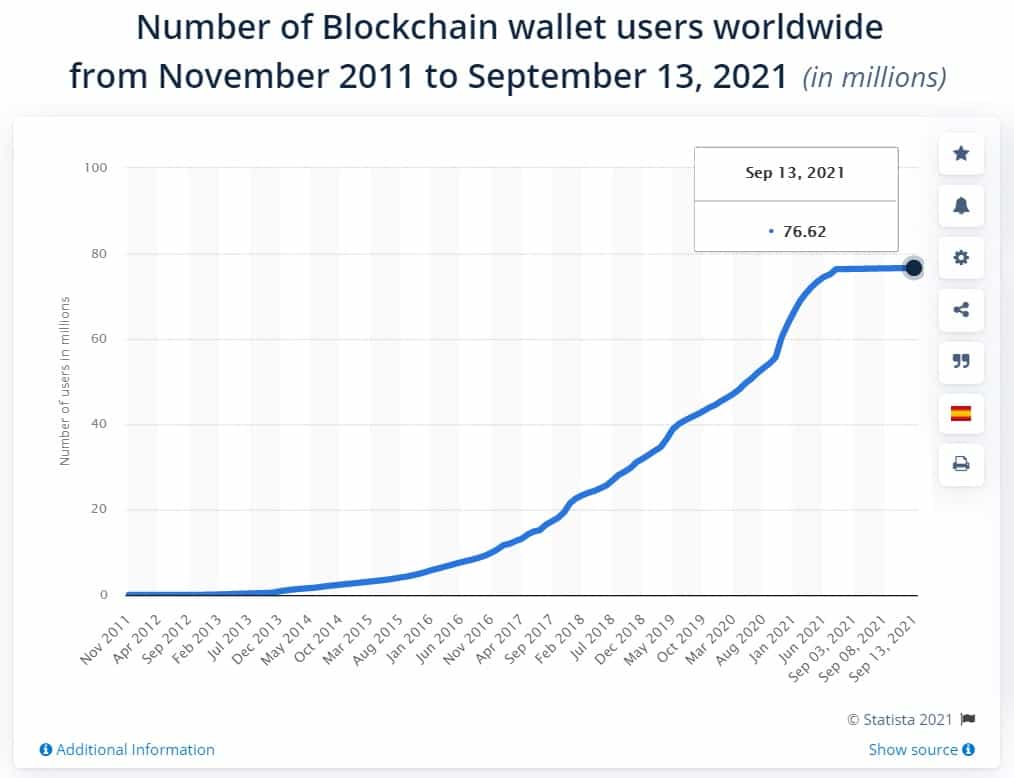 Three hundred million users, which is about the population of the U.S, have already got their feet wet in the world of cryptocurrencies. So it's safe to say that the remaining 7.5 billion people are likely to join while Bitcoin and other digital coins continue to make all-time highs.
Three hundred million users, which is about the population of the U.S, have already got their feet wet in the world of cryptocurrencies. So it's safe to say that the remaining 7.5 billion people are likely to join while Bitcoin and other digital coins continue to make all-time highs.
Here are some stats proving that crypto is rapidly becoming mainstream:
- 30+ crypto-related posts per minute on Twitter
- $2.16 trillion is the total cryptocurrency market cap as of September 2021
- 6000+ coins already exist
- $111 billion on average is the crypto trade volume
- $281m worth of cryptocurrencies stolen in 2020
Why You Should Create a Bitcoin Wallet
To do anything in crypto, one needs a crypto wallet — software for "storing" digital coins. Why the quotes? I'm glad you asked.
In reality, Bitcoin and other cryptocurrencies are stored on blockchains — peer-to-peer connected computers — where anyone can get an address to start sending and receiving crypto. To this extent, a crypto wallet is like a UI portal into the blockchain.
Related: Fintech App Development: Everything you Need to Know
Now, we can talk about all the advantages that blockchain technology passes on to cryptocurrencies, such as anonymity, decentralization, and security. However, if we're truly honest with each other, we'd have to agree that the main driver of crypto adoption is astronomic financial gains.
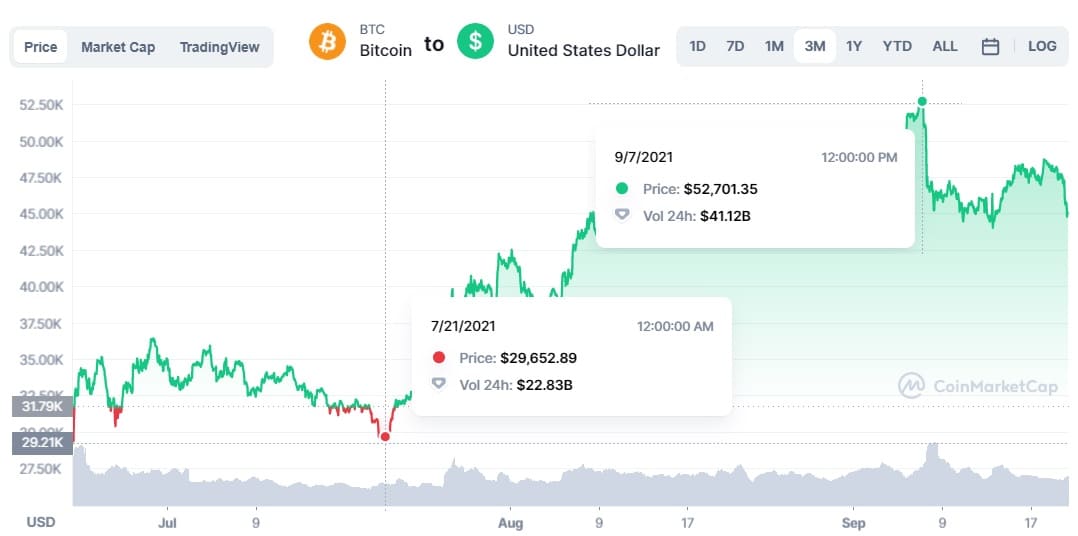
People learn about all the new possibilities to earn money with decentralized finance products and yearn for a slice of this mad pie. Only digital coins get to grow instantly by thousands of Xs.
That's where a crypto wallet comes into play.
This is the single way to onboard customers to any DeFi product, be it a crypto exchange, a lending platform, or some other novel financial product. Throw in banks and other incumbents looking to empower their clients with crypto trading and investing options, and there you have it — an immense demand for and an abundance of such solutions.
Types and Examples of Crypto Wallets
If you want to create a cryptocurrency wallet app, you need to understand what types of crypto wallets exist out there.
By governance
The first thing to consider is whether you want to create a centralized or decentralized wallet. These solutions are also commonly referred to as:
- custodial crypto wallets
- non-custodial crypto wallets
In the case of developing a custodial crypto wallet, you will generate private digital keys necessary for the wallet to operate on a server. There's a lot going on with these digital keys behind the surface but just think of them as an ordered string of words acting as a password to the wallet. That's how users typically perceive them.
Related: How to create an e-wallet app for digital payments
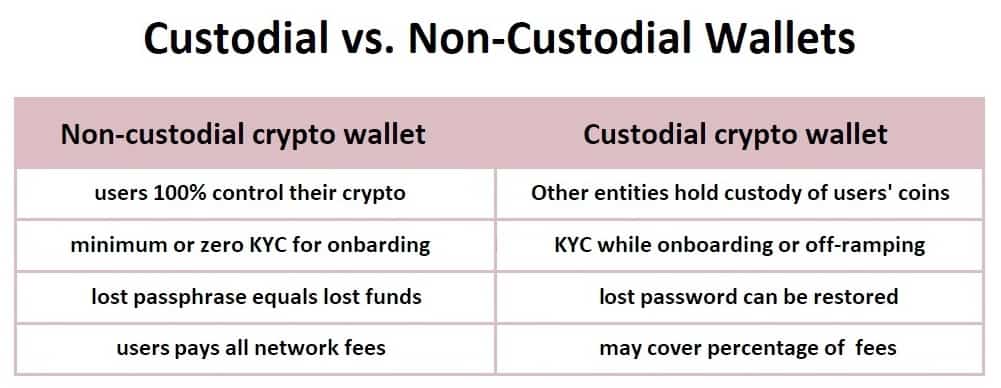 As for non-custodial crypto wallets, they generate this secret backup phrase on the client side, i.e., right inside the wallet application. As an upside to this scenario, customers don't have to rely on any third party to keep their funds safe: if only they own the keys to a wallet, no one else gets to access their money. As a favorite saying goes: "Not your keys, not your coins."
As for non-custodial crypto wallets, they generate this secret backup phrase on the client side, i.e., right inside the wallet application. As an upside to this scenario, customers don't have to rely on any third party to keep their funds safe: if only they own the keys to a wallet, no one else gets to access their money. As a favorite saying goes: "Not your keys, not your coins."
By platform
Depending on what software we are used to and what devices we own, we may run crypto wallets on various platforms:
- mobile
- desktop
- web
- hardware
It's worth noting that you don't need to settle for one platform when you plan to create your own bitcoin wallet. Users are likely to move between various gadgets throughout the day. Therefore it's a good idea to meet them where they are by offering your crypto wallet on different platforms.
For example, a super popular MetaMask crypto wallet operates as a browser extension, and as of late, as a mobile app for iPhone and Android smartphones. In addition, it can work with such popular hardware solutions for storing crypto as Trezor or Ledger. On the other hand, products like Lumi work as a web application, similar to Gmail.
Related: Mobile App vs Web: The Best Choice for your App
By coins availability
You'd be surprised, but not all wallets support all coins that you see on websites like CoinMarketCap. That's because coins may exist on different blockchain platforms. For example, Bitcoin operates only on the bitcoin network, while currencies like Dogecoin or Litecoin trade on the Ethereum blockchain.
Related: How to develop a blockchain app for your business
Developing and Deploying: Smart Contracts on Ethereum

So if you want to build a crypto wallet that works with many coins, it needs to be multi-currency, i.e., connect to different blockchain networks.
Popular apps for storing cryptocurrency:
- Trust Wallet
- MetaMask
- Crypto.com
- BRD
- Coinbase
- Exodus
Common Crypto Wallet Misconceptions
Crypto wallets are simple on the surface, but I think you can benefit from knowing a little more about how they operate. That way, you'll be better prepared to create a wallet solution for crypto that generates traction from the get-go.
People can easily switch from your app
If you're developing a non-custodial wallet, users can download another non-custodial app, enter their secret phrase, and start interacting with their crypto. On the contrary, if you offer a custodial wallet, people will have to stick with it to access their crypto.
Web wallets are the least secure option
While I agree that hardware and mobile crypto wallets have more protection out-of-the-box, web wallets are not necessarily less secure than desktop ones. Eventually, any crypto app can be hacked, and it's your responsibility to educate the customers about cyber hygiene and use cutting-edge tools to protect their funds.
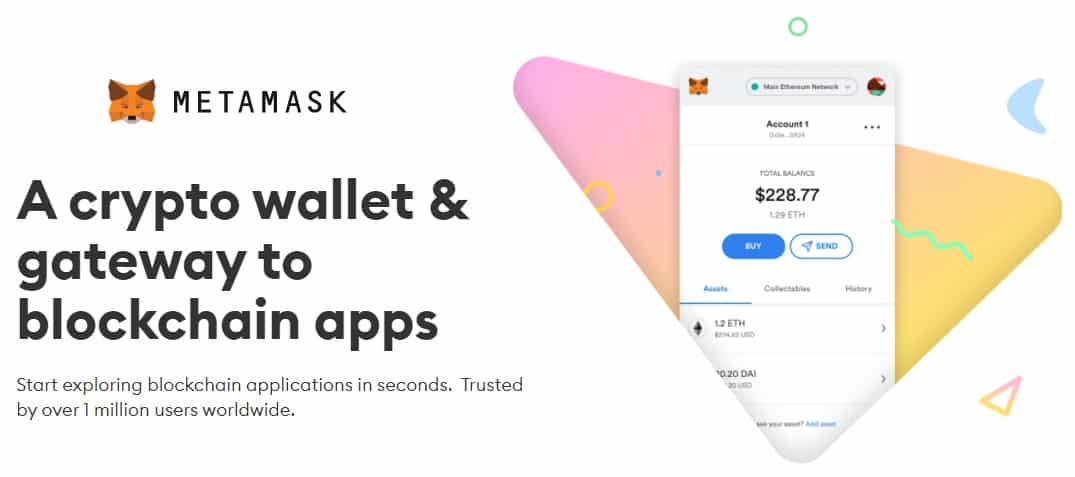 Take MetaMask, for example; it's one of the most popular wallets for crypto, primarily used as a web browser extension. Yet, there are very few instances of reported hacks.
Take MetaMask, for example; it's one of the most popular wallets for crypto, primarily used as a web browser extension. Yet, there are very few instances of reported hacks.
No one can see your transactions
If someone knows your address, they can follow all transactions connected with your account because all data is stored on the blockchain. Of course, that doesn't imply your product is compromised. This fact merely reflects one of the traits of blockchain technology — transparency.
Users can generate a new password to their crypto wallets
If users lose their mnemonic passphrase, they're out of luck accessing their funds. Unfortunately, that means they lose all their crypto, just like when we lose a real-life physical wallet. However, if you've built a custodial wallet, you can still help them regain access to their cryptocurrencies.
Key Features of a Cryptocurrency Wallet
What features should you plan to create and own a cryptocurrency wallet with a strong adoption? The basic components should include:
- Signup
- Profile with a bank account or a credit/debit card
- Favorite addresses
- QR codes for transactions
- Transaction history
- Crypto prices and charts
-
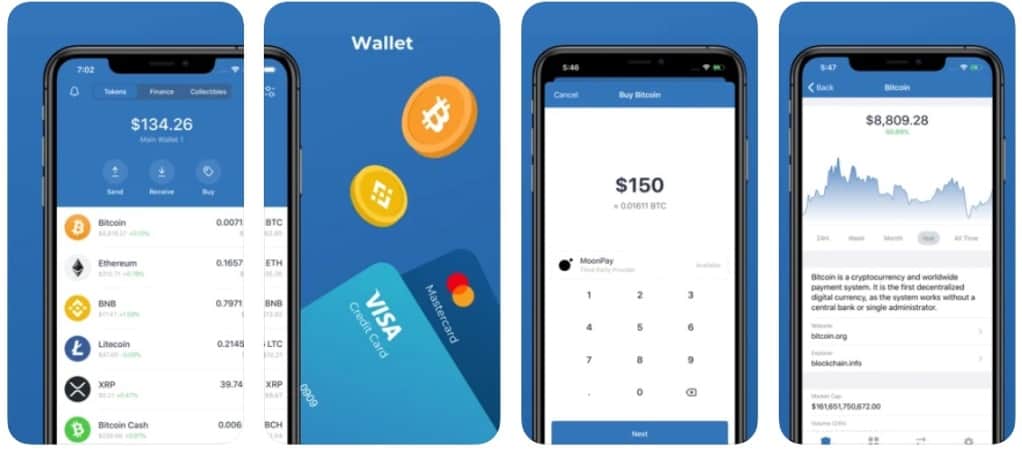 Notifications on significant price movements
Notifications on significant price movements - Security options (auto blur when in the background, iCloud keychain, pin, FaceID, multi-factor authentication, encryption)
I won't go into much detail on each of these features because it all comes down to your wallet specifics. However, to give you an idea of what development effort stands behind such a simple feature as signup, here are the things a skillful blockchain developer would have to consider:
- semi-automatic switching between the wallet app, email, and browser (while the user goes through the registration process)
- double-check if the user has written down his passphrase by making him order the words correctly
- a KYC process with image recognition (to accurately scan a state ID) plus AI for face and text recognition
- referral codes for bonuses attribution (AppsFlyer or similar)
- PIN code generation, FaceID integration
- blurring a portion of a secret mnemonic phase so the user can write it down without worrying about passersby peeking
- a FAQ links for users who can't log in
All in all, there's a lot to take into account when trying to achieve buttery smooth onboarding for new customers. Now extrapolate that to more complex crypto wallet features, and you get a clear picture of why it's quite the challenge.
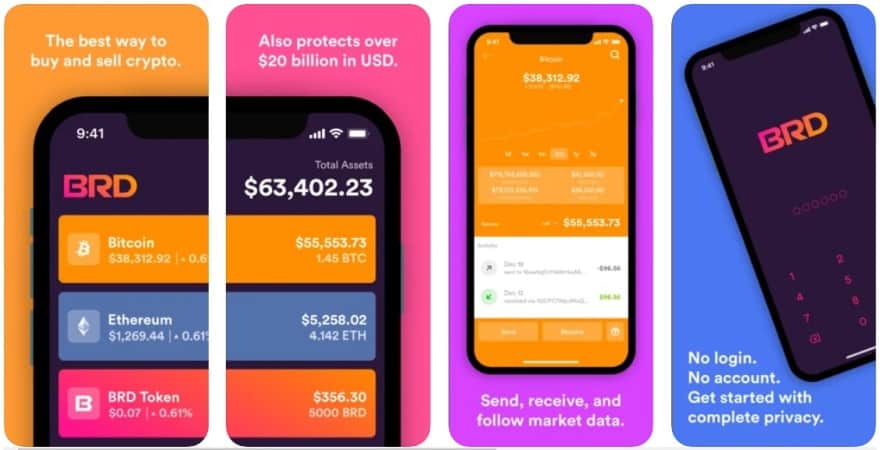
Advanced Features of a Bitcoin Wallet
To make your crypto wallet even more attractive to customers, enhance it with more state-of-the-art features:
- Paper wallet import
- Ability to adjust fees during transactions
- Airdrop listings
- Multiple coin addresses (to support various coins right out of the gate)
- Scheduled purchase orders
- Custom notifications on preferred price movements
- Dark mode / quick web login / direct integrations with DeFi products
When it comes to advanced functionality, it's easy to get lost and go over budget, especially if that's your first attempt at mobile app development. I recommend you plot most of such features on the roadmap and pick only a few for the minimum viable product you will launch initially.
Challenges You May Face When You Make a Bitcoin Wallet
What issues are you likely to run into during your crypto wallet development? The most common technical and business challenges include:
- Blockchain forks, which happen not so often, but when they do, you need to decide which version of a blockchain your wallet will support
- The necessity to integrate with multiple blockchains to support more coins

- Despite the hype, adoption is still a challenge because most customers interact with many unknowns for the first time
- Most crypto products that fail rarely get a second chance, at least under the same brand
- Finding a capable team of developers who are equally versed in user-centric design and blockchain technology
Speaking of technologies, let's quickly review the tech stack required for building a crypto wallet in the next section.
Technology Stack for Cryptocurrency Wallet Development
First of all, different teams choose technologies based on their experience. Therefore, it's entirely possible to work with varying stacks of tech to build crypto wallets. At the same time, there will need to be some basic blockchain foundation for such crypto projects. Here's an example of a tech stack that will work.
Read our article: How to Choose Your Tech Stack
Mobile apps
This one is pretty easy: Kotlin for Android, Swift for iOS. These native programming languages supported by Google and Apple offer the most advanced toolsets for making a mobile crypto wallet for iPhones and Android smartphones.
Related: Choosing the right framework for your mobile app
Web
React and Node.js are modern web development tools with plenty of instruments available on the market.
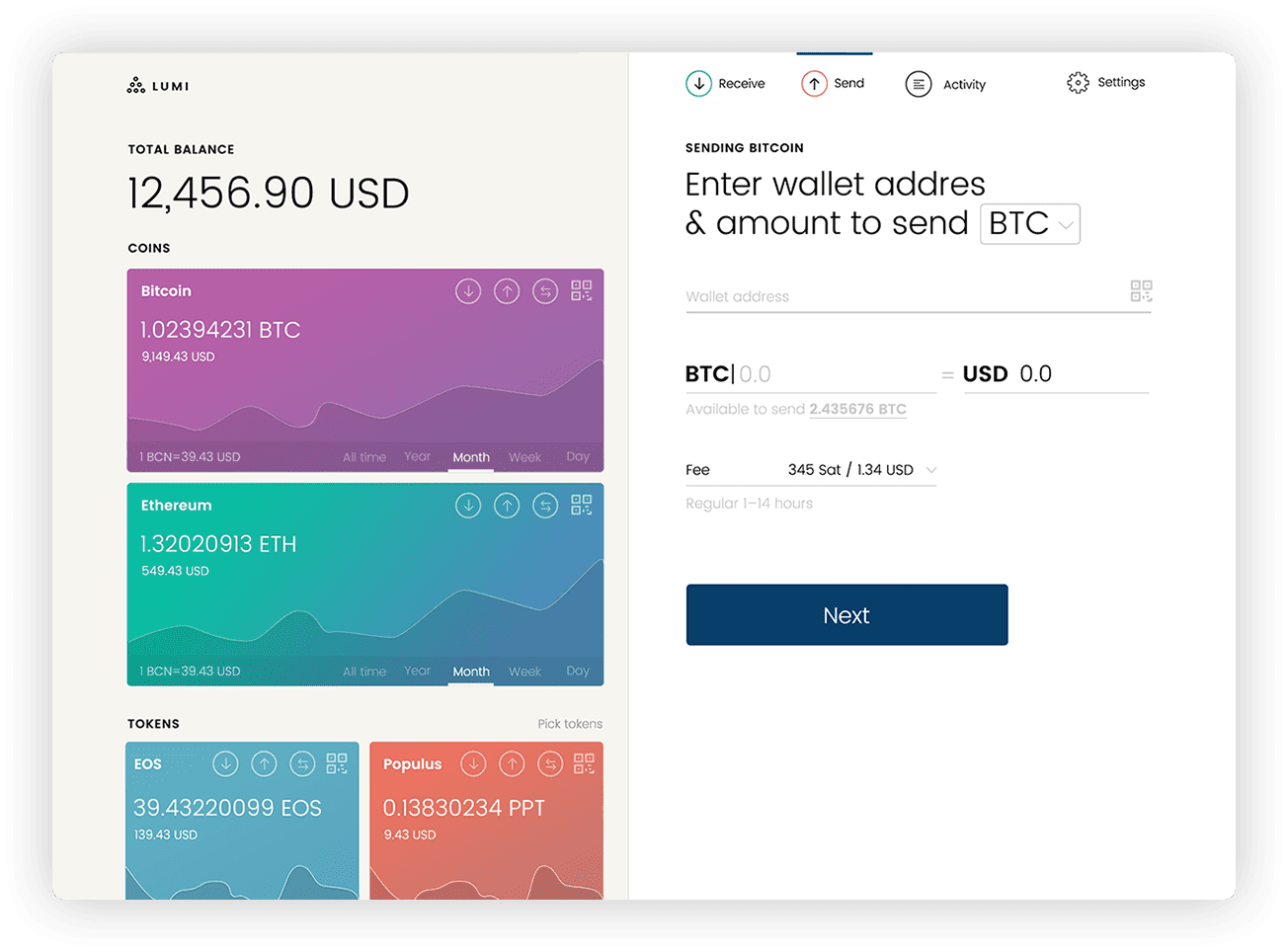 By the way, if you want a cross-platform crypto wallet that will work on mobile phones and in desktop browsers, you may opt for React Native or Flutter, to reuse some "mobile" code for the web app.
By the way, if you want a cross-platform crypto wallet that will work on mobile phones and in desktop browsers, you may opt for React Native or Flutter, to reuse some "mobile" code for the web app.
Related: Choosing the right framework for your web app
Server-side specifics
You'll need Kubernetes and Docker for building a scalable architecture; Golang and Solidity (at a minimum) to take care of smart contract development (in case your wallet will connect with a DeFi app); and then Python, Ruby, or any programming language that will serve to make the back end admin portal.
That's really a barebones description of a tech stack for developing a crypto wallet. Think of it as yet another incentive to collaborate with your development partner if they have some experience working with these technologies. We also shared more details about how to create a blockchain application in a separate blog.
How to Create a Bitcoin Wallet in 5 Steps
What steps do you need to take to make your own cryptocurrency wallet? There are quite a few things to consider. I suggest we go through all of them one by one.
Step #1: Start by generating a valid business idea
Crypto wallet development begins with an idea. The industry is still in its infancy, and many product ideas emerge from our personal experiences as we navigate around different weird issues.
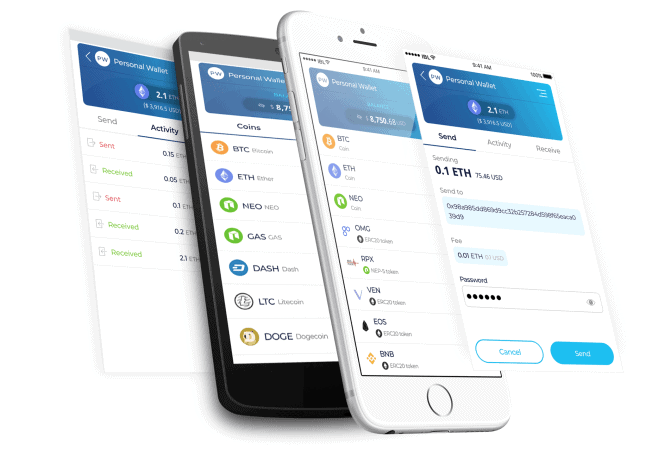
As you uncover new challenges while dealing with crypto and seek a solution, you'll inevitably have to run competitive research. People may have already created a product to solve the problem you've stumbled upon. If that's the case, study the product and think about ways to enhance it and make it more appealing to your audience.
In general, you'd want to make your own bitcoin wallet in two cases:
- when you're working on a DeFi app (and need to onboard customers)
- when you have an idea for a crypto wallet with novel features
Example
Let's say you want to make a cryptocurrency wallet that allows customers not only to receive and send transactions but also to track their entire portfolio of coins, those they hold in their wallets, and those they've staked to gain interest.
That's actually an example of a crypto wallet app I've been personally looking for, to no avail. Most crypto apps excel at displaying your total crypto balance based on current coin prices. However, if you happen to stake some of these coins, you'll have no means of tracking the interest gains directly in your wallet.
Now that you have an idea and know your competitors or lack thereof, reach out to other people and find out how they tackle this issue.
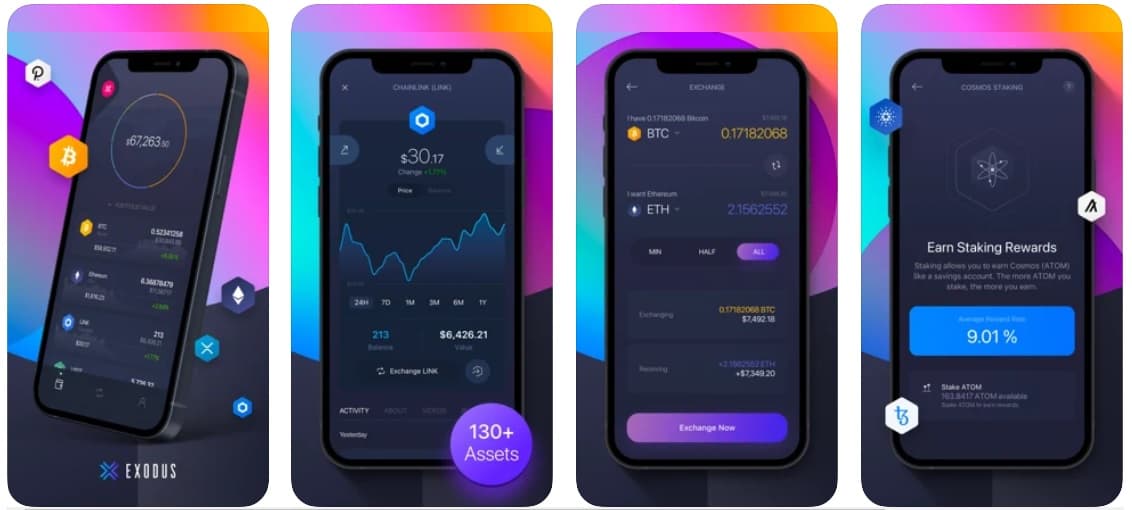 Talk to everybody willing to share their experiences: friends, family members, colleagues, random strangers on the internet.
Talk to everybody willing to share their experiences: friends, family members, colleagues, random strangers on the internet.
Sum up all the feedback you've gathered in the form of use cases and then map them to potential features your crypto wallet needs to have. The more you know about other people's experiences with the challenge you've identified, the better you'll be equipped to design a compelling crypto product.
Advice :
- Work on a draft version of a lean canvas for your project
- Describe your target audience in as many details as possible
- Think through your monetization strategy
Step #2: Find a development partner
Once you've identified that your crypto app idea has a potential for strong demand, it's time to proceed to the next step. The reality is you will need a reliable developer to build a cryptocurrency wallet.

Ideally, you want to find a one-stop shop — a software development agency with enough experts who can follow through on your product idea from start to finish. What specialists will you need for crypto wallet development?
- Product managers
People who can pick holes in your business idea and offer alternatives. People who align your ROI goals with technical aspects of the product. They usually come with the development background and oversee the entire engagement from discovery to development to release and maintenance.
- Project managers
PMs are more hands-on with translating your business idea into a tangible product. They coordinate designers, QA engineers, developers, DevOps, and everybody else involved in realizing your vision.
- UX/UI designers
Because crypto wallets serve as a kind of portal to blockchains (where crypto really lives), your app will need an engaging UI optimized for your target audience. UX/UI engineers handle that.
Related: UI/UX Guidelines to designing a winning app
- Developers
Now, this is a very general term. Still, you should know that there will be different software engineers working on developing your bitcoin wallet: blockchain developers, back-end developers, front-end developers, mobile developers.
-
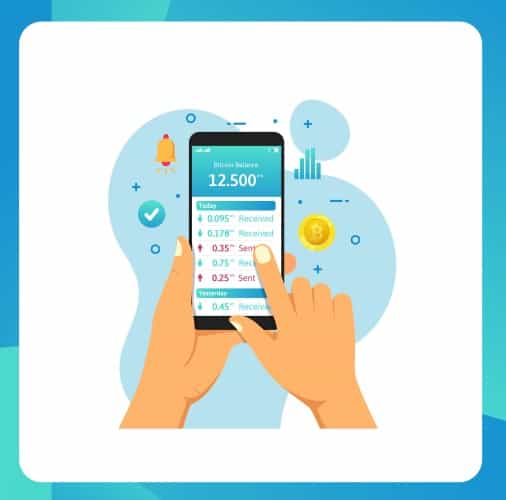 Testers
Testers
Developers aren't good at testing their code (especially from the customer perspective), plus you'll need to include robust security tests. So, having QA specialists on such a project is a must.
- DevOps
DevOps engineers mostly come from the server development or software administration spaces. They know how to set up the tools allowing an uninterrupted development process. That will be key for smooth development and any future updates to your crypto wallet app.
Advice:
- look for companies with previous experience in crypto development
- review the apps they built and speak to their clients
- shy away from agencies that ask zero questions and instead come back with a quote
In the perfect world, when you find a capable team, you can start with a discovery session — to share your idea and get their feedback on technical feasibility, potential challenges to implementation, the optimal strategic roadmap, etc. That's how you know if you're partnering with someone rather than hiring a team, and needless to say, partners have a vested interest in your success.
Step #3: Create an interactive prototype
Once you've selected a team to create a wallet for cryptocurrency, your next steps are going to be:
- creating an interactive prototype of your app
- development of a minimum viable product (MVP)
- public release and maintenance

Why do you need to invest in creating a prototype before actually developing an MVP? The reason is coding is expensive, especially blockchain-related programming where demand greatly exceeds supply. The technology is still in its infancy, and there aren't many qualified blockchain developers available.
On the other hand, a prototype costs way less to develop and serves as a means to find the perfect balance of features and UX for your crypto wallet to generate the most traction at launch. That's also an ideal tool for pitching your idea to investors.
So what is an interactive prototype? It's a virtual representation of your app, with all screens designed and interlinked so test users can play with it and help you discover areas for improvement. You can learn more about how we approach this step on our rapid prototyping page.
Advice:
- share the prototype with your target audience on platforms like usertesting.com to ensure it effectively addresses users' needs
- verify that you've accurately implemented their recommendations with another round of testing
Step #4: Develop and test an MVP
After the prototype has been tested, it's time to make your own bitcoin wallet a reality. I won't pretend like any advice on how to make a bitcoin wallet in this coding step will make any sense to you. You will need to trust your developers.

The couple of things you'll have to decide (again, using your dev partner's advice) is what kind of a crypto wallet you envision:
- custodial
- non-custodial
And which platforms you want to target from the get-go. Think about MetaMask. Why did they initially release their wallet as a browser-based extension? Because blockchain is originally a desktop-centric, networked technology, and there are plenty of instruments to develop a bitcoin wallet on this platform. Because people are likely to appreciate using this product while browsing through coin charts that usually occupy a lot of space on the screen, and a pop-up window in the corner doesn't stand in the way.
By the way, speaking of available crypto APIs and SDKs — that's another decision you will need to delegate to your team. While they can use specific APIs, like Wyre API to quickly enable crypto on-ramps and off-ramps, or something like PayString to simplify management of payment addresses, anything more serious will need thorough investigation.

Let's list a few technical questions your team will need to decide on so you better understand what goes into cryptocurrency wallet development:
- different tokens require addresses on different blockchains — do you want to open them all automatically for all listed coins, for some cryptos, or upon the user's request?
- do your users know anything about transaction fees — do you want to include UI for them to fiddle around with this?
- do you want to issue a new bitcoin address in the background for each bitcoin transaction?
- should you integrate with Keychain on iOS to securely store the wallet's digital keys?
This is only the tip of the iceberg of things you and your development partner will need to go through when you build your own bitcoin wallet. As long as the team is full-stack, has a proven UX/UI expertise, offers full-cycle development, and excels at the tech stack I've outlined above — you should be in safe hands.
Advice:
- insist on Agile development and agree on a regular cadence for reviewing interim results
- make sure you and your employees only deal with thoroughly tested versions
- run a security audit once the crypto wallet has been developed
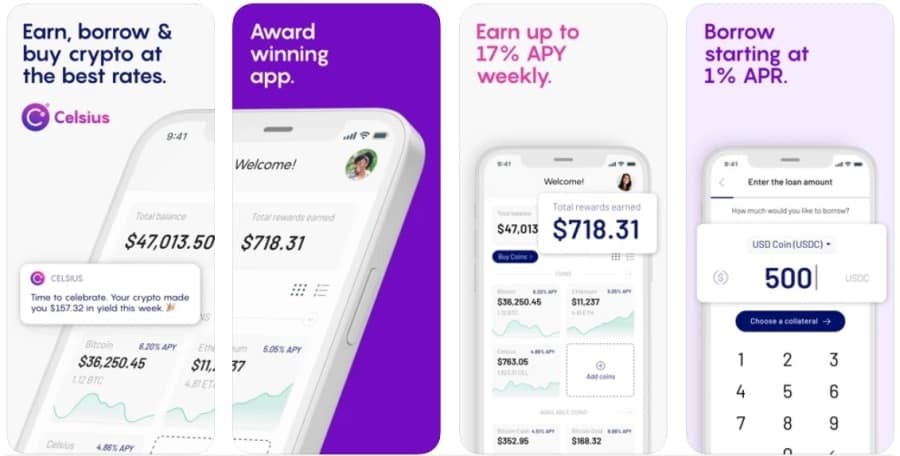 Step #5: Release and Maintain
Step #5: Release and Maintain
We've arrived at the final step at last. Why do we want to make a crypto wallet? That's right — to onboard new users and let them get value from our DeFi app or participate in the crypto ecosystem at large.
As with most mobile applications, when you go public, you need to upload your crypto wallet apps to the App Store and Google Play and switch the server side to a production-ready environment.
One additional step is to disconnect the wallet from a test blockchain used during development and testing and hook it with a live blockchain network. Depending on supported coins, you may need to connect your wallet with multiple blockchains.
Advice:
- Always stress test your servers to see how well they manage a massive influx of customers
- Release the production version of the crypto wallet for a limited number of users to see how it operates on a larger set of users
- Get ready to handle feature requests if all goes smoothly (UserVoice or similar)
How Much Does it Cost to Develop a Crypto Wallet?
Budget in between $120,000 and $200,000 to build your own bitcoin wallet that introduces some genuine value and prompts novel crypto use cases.
However, if all you have is an idea, it's best to start with the discovery phase (we call it Pre-flight Workshop) and then formalize your concept into a rapid prototype, which usually costs around $20K.
Related: App Development Costs: The Complete Guide
Our Experience in Crypto Wallet Development
We are finishing a crypto staking app that abstracts the crypto away from customers, who instead can focus on fiat earnings the app generates via DeFi lending protocols. Naturally, a crypto wallet is one of the prerequisites for such a project, even though it remains behind the scenes for simpler user onboarding for this particular project.
Feel free to reach out to our experts if you have more questions about building a cryptocurrency wallet.
Frequently Asked Questions
How long does it take to create a crypto app?
From 4 to 8 months, depending on its functionality.
Do you recommend custodial or non-custodial app development?
Depends on how much freedom you want to provide to your customers. In a non-custodial scenario, they are basically free to move on to any other crypto wallet later on.
Do crypto wallets enable only peer-to-peer transactions?
Users can send cryptocurrencies to businesses and to smart contracts too. The latter receive payments to initiate built-in algorithms and perform some action.
Can I build a crypto-storing app for iOS and Android using React Native or similar company?
Should I rely on third party crypto SDKs/APIs or build everything from scratch?
Both options are viable. However, use some crypto services sparingly to go to market faster and on a smaller budget.
What kind of developer do I need to build a crypto app?
You will need a team with blockchain development expertise. A single developer won't cut it. With a team that has resources for designing, developing, and testing your product, you have a better chance to win.
X
1 out of 10,000 Apps is a Success. How do you ensure it's yours?
Konstantin has worked with mobile apps since 2005 (pre-iPhone era). Helping startups and Fortune 100 companies deliver innovative apps while wearing multiple hats (consultant, delivery director, mobile agency owner, and app analyst), Konstantin has developed a deep appreciation of mobile and web technologies. He's happy to share his knowledge with Topflight partners.
Looking for help with your app?
From a prototype to a full-blown app, we'll help you hit the market
in record time with a product that's set to win.
We can help with:
Schedule a Consultation
 Strategy
Strategy
From a prototype to a full-blown app, we'll help you hit the market in record time with a product that's set to win.
 Design
Design
Your app will have a unique visual appeal engaging your customers way beyond average digital experiences.
 Development
Development
We'll pick relevant technology pieces for your app to make it secure and easy to scale up and maintain.
Schedule a Consultation
How To Create Own Cryptocurrency Wallet
Source: https://topflightapps.com/ideas/how-to-build-a-crypto-wallet-app/
Posted by: hamiltonwathre.blogspot.com



0 Response to "How To Create Own Cryptocurrency Wallet"
Post a Comment